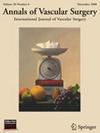神经源性胸廓出口综合征住院康复3周对力量、疼痛和功能的影响:一项前瞻性研究。
IF 1.6
4区 医学
Q3 PERIPHERAL VASCULAR DISEASE
引用次数: 0
摘要
目的:神经源性胸廓出口综合征(NTOS)是由于臂丛受压引起的,可导致上肢疼痛、力量丧失和疲劳,从而导致日常生活障碍。我们前瞻性地评估了3周住院康复对NTOS患者上肢力量和耐力的影响,并评估了患者的疼痛和功能。方法:220例以康复为目的的NTOS患者。患者在康复开始和结束以及24周时进行肩袖等速测试和手部力量等速测量。患者完成QuickDASH问卷,并使用数字评定量表(NRS)评估疼痛。病假率也进行了评估。结果:220例患者中有182例进行了3次评估,其中女性占78%,平均年龄40.7±9.7岁。最初,有症状的上肢力量明显低于无症状的上肢。24周时,有症状肩关节的旋转体强度从13%增加到18%,有症状肩关节的旋转体强度从4%增加到12.5%;有症状肩关节的旋转者耐力从35%增加到39%,无症状肩关节的旋转者耐力从20%增加到22% (p≤0.001)。握力和键捏措施在有症状的手上分别增加22%和13%,在无症状的手上分别增加12%和8% (p≤0.001)。QuickDASH由57±14%降至30±19% (p≤0.001),NRS由5.6±1.8降至2.4±2.0 (p≤0.001)。病假率从66%下降到43% (p≤0.0001)。结论:NTOS患者住院康复三周后,双手和肩膀的双侧上肢力量和耐力得到了显著的恢复,并在24周时保持了这一结果。这些结果与疼痛和损伤的显著减少有关。本文章由计算机程序翻译,如有差异,请以英文原文为准。
Effects of a 3-week Inpatient Rehabilitation for Neurogenic Thoracic Outlet Syndrome on Strength, Pain, and Function: A Prospective Study
Background
Neurogenic thoracic outlet syndrome (NTOS) is due to the compression of the brachial plexus and is responsible for upper limb pain, strength loss and fatigability, which are responsible for daily life impairment. We assessed prospectively the effect of a 3-week inpatient rehabilitation on upper limb strength and endurance, and to assess pain and function in patients with NTOS.
Methods
Among patients with NTOS, 220 addressed to rehabilitation were included. Patients performed a shoulder isokinetic testing of the rotator cuff and an isometric hand strength measurement, at the beginning and the end of the rehabilitation, and at 24 weeks. Patients completed a QuickDASH questionnaire, and pain was evaluated with a numeric rating scale (NRS). Sick leave rate was also assessed.
Results
Out of 220 patients, 182 performed the 3 evaluations: 78% were female, mean age was 40.7 ± 9.7 years. Initially, symptomatic upper limbs had significantly less strength than asymptomatic upper limbs. At 24 weeks, the rotators strength had increased from 13 to 18% on symptomatic shoulders, and from 4 to 12.5% on asymptomatic shoulders; the rotators endurance increased from 35% to 39% on symptomatic shoulders and from 20% to 22% on asymptomatic shoulders (P ≤ 0.001). The grip and key-pinch measures increased by 22% and 13%, on symptomatic hands, respectively, and by 12% and 8%, on asymptomatic hands, respectively (P ≤ 0.001). The QuickDASH decreased from 57 ± 14% to 30 ± 19% (P ≤ 0.001) and the NRS from 5.6 ± 1.8 to 2.4 ± 2.0 (P ≤ 0.001). The sick leave rate decreased from 66 to 43% (P ≤ 0.0001).
Conclusion
Three weeks of inpatient rehabilitation for NTOS permitted to recover significant bilateral upper limb strength and endurance, both on hands and shoulders, with a maintenance of the results at 24 weeks. These results were associated to a significant reduction of pain and impairment.
求助全文
通过发布文献求助,成功后即可免费获取论文全文。
去求助
来源期刊
CiteScore
3.00
自引率
13.30%
发文量
603
审稿时长
50 days
期刊介绍:
Annals of Vascular Surgery, published eight times a year, invites original manuscripts reporting clinical and experimental work in vascular surgery for peer review. Articles may be submitted for the following sections of the journal:
Clinical Research (reports of clinical series, new drug or medical device trials)
Basic Science Research (new investigations, experimental work)
Case Reports (reports on a limited series of patients)
General Reviews (scholarly review of the existing literature on a relevant topic)
Developments in Endovascular and Endoscopic Surgery
Selected Techniques (technical maneuvers)
Historical Notes (interesting vignettes from the early days of vascular surgery)
Editorials/Correspondence

 求助内容:
求助内容: 应助结果提醒方式:
应助结果提醒方式:


